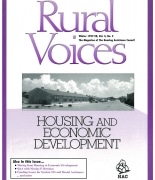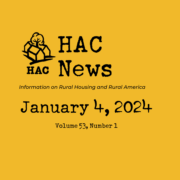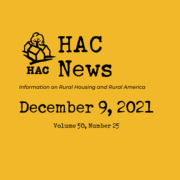Discussion Paper, USDA
REDUCED USDA PRESENCE AND RESOURCES – HOW CAN RURAL HOUSING ORGANIZATIONS ADAPT?
 Continue the Discussionby Tom Collishaw, Self Help Enterprises, CA, and Selvin McGahee, Florida Non-Profit Housing, FL
Continue the Discussionby Tom Collishaw, Self Help Enterprises, CA, and Selvin McGahee, Florida Non-Profit Housing, FL
Background
USDA budgets and allocations for major housing production programs have trended downward since the late 1970s. In recent years, even the agency’s physical presence in rural America has lessened dramatically. Historic core housing production programs have been cut so much that, for example, Section 515 Rural Rental Housing has been reduced to little more than a maintenance and repair effort. Single-family direct lending through the Section 502 mortgage program has likewise been a dwindling resource. It feels as if the current administration, given the choice, would focus entirely on mortgage insurance (502 guaranteed loans) and maintenance efforts (Rental Assistance) and call it “Rural Housing.” The current level of funding for USDA’s housing programs is due largely to the efforts of rural housing advocates from throughout the country and their lobbyists going directly to Congress.
Given this sobering reality, rural housing development organizations have adapted by accessing a broader range of assistance, ranging from Low Income Housing Tax Credits and federal HUD programs such as HOME, FHA and CDBG, to non-governmental resources such as LISC, Enterprise, and NeighborWorks®, and a variety of state and local programs. Many of these sources have also been cut or depleted, most notably HUD allocations, intensifying the resource-deprived and competitive environment for rural housing providers.
Issues, Challenges, and Opportunities
With dwindling resources as a backdrop, a central question is whether rural housing organizations should continue to focus their primary federal advocacy efforts on USDA or expand them to include other agencies. Are there opportunities being missed, for instance, with the Affordable Care Act? There is a growing movement around health (both individual and community environmental health) and its relationship to housing, which may create new avenues to resources and relationships. How would we preserve a dedicated slice of this pie for rural communities?
On the non-governmental front, there is increasing evidence that “impact investing” is a largely untapped resource for nonprofit housing organizations, who might benefit from favorable lending rates in return for providing investors with social impacts they believe in. Also, the world of social media and crowdsourcing has opened up new possibilities for fundraising.
Discussion Questions
- Are USDA programs worth fighting for or are they a lost cause in the long run?
- What other federal agencies or programs should rural housers pursue as partners?
- Are there examples of collaboration with other community health or improvement efforts that have been useful in expanding resources for rural housing?
- What other tactics have been successful?



